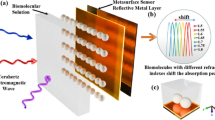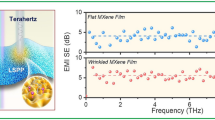Abstract
A five-band polarization-insensitive perfect metamaterial absorber (PMA) is reported in this paper for THz detection and sensing applications. The proposed absorber is constructed using interconnected circular ring elements enclosed by a square loop. The ring elements are interconnected using short strip lines which increases the electrical length to offer resonance at the lower frequencies of the THz regime without increasing the electrical length. The proposed absorber has a footprint of 0.12 λeff × 0.12 λeff where λeff is the effective wavelength calculated at the lowest operating frequency. The absorber provides 92%, 84%, 90%, 100%, and 100% absorption at 0.24, 0.56, 0.65, 0.82, and 0.95 THz, respectively. The proposed structure offers structural symmetry, and hence, it is polarization-insensitive. The proposed five-band absorber has good angular stability consistent with many research works reported in the literature and has a small frequency ratio of 1:2.3:2.7:3.4:3.9. The proposed absorber can be used as a permittivity sensor and its sensitivity is estimated to vary from 5.8 GHz/permittivity unit (PU) to 23.56 GHz/PU.












Similar content being viewed by others
Availability of Data and Material
No new data generated.
Code Availability
The work does not involve any software codes.
References
Shamshirband S, Petković D, Amini A, Anuar NB, Nikolić V, ĆojbašićLaiha Mat Kiah ŽM, Gani A (2014) Support vector regression methodology for wind turbine reaction torque prediction with power-split hydrostatic continuous variable transmission. Energy 67:623–630
DaliborPetković (2017) Prediction of laser welding quality by computational intelligence approaches. Optik – Int J Light Electron Opt 140:597–600
Shamshirband S, Petković D, Javidnia H, Gani A (2015) Sensor data fusion by support vector regression methodology—a comparative study. IEEE Sens J 15(2):850–854
Jović S, Danesh AS, Younesi E, Aničić O, Petković D, Shamshirband S (2016) Forecasting of underactuated robotic finger contact forces by support vector regression methodology. Int J Pattern Recognit Artif Intell 30(7):1659019
Nikolić V, Petković D, Lazov L, Milovančević M (2016) Selection of the most influential factors on the water-jet assisted underwater laser process by adaptive neuro-fuzzy technique. Infrared Phys Technol 77:45–50
Milovančević M, Nikolić V, Petkovic D, Vracar L, Veg E, Tomic N, Jović S (2018) Vibration analyzing in horizontal pumping aggregate by soft computing. Measurement 125:454–462
Petković D, Nikolić V, Mitić VV, Kocić L (2017) Estimation of fractal representation of wind speed fluctuation by artificial neural network with different training algorithms. Flow Meas Instrum 54:172–176
Gavrilović S, Denić N, Petković D, Živić NV, Vujičić S (2018) Statistical evaluation of mathematics lecture performances by soft computing approach. Comput Appl Eng Educ 26:902–905
Nikolić V, Mitić VV, Kocić L, Petković D (2017) Wind speed parameters sensitivity analysis based on fractals and neuro-fuzzy selection technique. Knowl Inf Syst 52(1):255–265
Petković D, Pavlović NT, Ćojbašić Ž (2016) Wind farm efficiency by adaptive neuro-fuzzy strategy. Int J Electr Power Energy Syst 81:215–221
Landy NI, Sajuyigbe S, Mock JJ, Smith DR, Padilla WJ (2008) Perfect metamaterial absorber. Phys Rev Lett 100:207402
Grant J, Ma Y, Saha S, Lok LB, Khalid A, Cumming DRS (2011) Polarization insensitive terahertz metamaterial absorber. Opt Lett 36(8):1524
Ding F, Cui Y, Ge X, Jin Y, He S (2012) Ultra-broadband microwave metamaterial absorber. Appl Phys Lett 100(10):103506
Pan W, Yu X, Zhang J, Zeng W (2016) A novel design of broadband terahertz metamaterial absorber based on nested circle rings. IEEE Photonics Technol Lett 28(21):2335–2338
Hu D, Wang H, Tang Z et al (2016) Design of four-band terahertz perfect absorber based on a simple #-shaped metamaterial resonator. Appl Phys A 122:826
Meng T, Hu D, Zhu Q (2018) Design of a five-band terahertz perfect metamaterial absorber using two resonators. Opt Commun 415:151–155
Meng H-Y, Wang L-L, Zhai X, Liu G-D, Xia S-X (2017) A simple design of a multi-band terahertz metamaterial absorber based on periodic square metallic layer with T-shaped gap. Plasmonics 13(1):269–274
Xu Z-C, Gao R-M, Ding C-F, Zhang Y-T, Wu L, Xu D-G, Yao J-Q (2015) A broadband planar THz metamaterial absorber. Mod Phys Lett B 29(12):1550056
Yao G, Ling F, Yue J, Luo C, Ji J, Yao J (2016) Dual-band tunable perfect metamaterial absorber in the THz range. Opt Express 24(2):1518
Guiming H (2018) Design and measure of a tunable double-band metamaterial absorber in the THz spectrum. Mater Res Express 5(4):45803
Cen C, Yi Z, Zhang G, Zhang Y, Liang C, Chen X, Hua J (2019) Theoretical design of a triple-band perfect metamaterial absorber in the THz frequency range. Results in Physics 14:102463
He Y, Wu Q, Yan S (2019) Multi-band terahertz absorber at 0.1–1 THz frequency based on ultra-thin metamaterial. Plasmonics 14:1303–1310
Jia W, Bai J, Roberts K, Le KQ, Zhou D (2020) Design and simulation of a polarization-insensitive metamaterial terahertz absorber with five bands. Microw Opt Technol Lett 62(8):2649–2655
Wang BX, Zhai X, Wang GZ, Huang WQ, Wang LL (2015) Design of a four-band and polarization-insensitive terahertz metamaterial absorber. IEEE Photonics J 7(1):1–8
Liu Y, Xu S-Q, Liu M, Hu X-G, Duan Y-F, Yi L (2018) Tunable multi-band terahertz absorber based on a one-dimensional heterostructure containing semiconductor. Optik 170:203–209
Author information
Authors and Affiliations
Contributions
Vijayalakshmi K–research scholar involved in the design and paper writing. Kanimozhi Selvi C S–main supervisor involved in research problem generation and paper drafting.
Corresponding author
Ethics declarations
Competing Interests
The authors declare no competing interests.
Additional information
Publisher's Note
Springer Nature remains neutral with regard to jurisdictional claims in published maps and institutional affiliations.
Rights and permissions
About this article
Cite this article
Kannaiyan, V., Sadhasivam, K.C. Miniaturized Five-Band Perfect Metamaterial THz Absorber with Small Frequency Ratio. Plasmonics 17, 79–86 (2022). https://doi.org/10.1007/s11468-021-01500-y
Received:
Accepted:
Published:
Issue Date:
DOI: https://doi.org/10.1007/s11468-021-01500-y




